Static Softening Behavior and Modified Kinetics of Al 2219 Alloy Based on a Double-Pass Hot Compression Test
Abstract
1. Introduction
2. Materials and Methods
3. Results and Discussion
3.1. Static Softening Mechanism
3.1.1. True Stress–Strain Curve
3.1.2. Microstructure Evolution
3.2. New Expression for Static Softening Fraction
3.2.1. The Determination of L1L
3.2.2. The Determination of LyL
3.3. Modified SRX Kinetics
3.3.1. Determination of n
3.3.2. Determination of t0.5
4. Conclusions
- The static softening mechanism of the Al 2219 alloy is mainly SRV and incomplete SRX, which is determined via step phenomenon and microstructure detection;
- The step rate of the first- and second-pass are represented by the equivalent dynamic recrystallization fraction in the form of flow stress, which increases with the increase in strain rate and isothermal insulation time, while it decreases with the increase in temperature and strain;
- A new expression for the SRX fraction is proposed based on the reduction rate of the sub-grain boundary. Compared with the traditional stress method, the new expression method is derived from the micro perspective, and the data obtained from experiment and EBSD observation are more real and effective, which is feasible in theory and practice and is applicable to samples of all processing states. The dependent rule on deformation parameters is consistent with the step rate, and it is of physical significance;
- The SRX kinetic model considering all of the deformation factors established in this paper has good modeling and prediction performance under the given deformation conditions, with a correlation coefficient of 0.903 and a relative error of 13.7%, and the method can be applied to other similar materials.
Author Contributions
Funding
Conflicts of Interest
References
- He, H.; Yi, Y.; Huang, S.; Zhang, Y. An improved process for grain refinement of large 2219 Al alloy rings and its influence on mechanical properties. J. Mater. Sci. Technol. 2019, 35, 55–63. [Google Scholar] [CrossRef]
- Guo, W.; Yi, Y.; Huang, S.; Mao, X.; Fang, J.; He, H.; Hu, B. Effects of deformation temperature on the evolution of second-phase and mechanical properties of large 2219 Al-Cu alloy rings. Mater. Charact. 2020, 160, 110094. [Google Scholar] [CrossRef]
- Zhang, D.; Zhao, Y.; Dong, M.; Wang, G.; Wu, A.; Shan, J.; Meng, D.; Liu, X.; Song, J.; Zhang, Z. Effects of weld penetration on tensile properties of 2219 aluminum alloy TIG-welded joints. Trans. Nonferrous Met. Soc. China 2019, 29, 1161–1168. [Google Scholar] [CrossRef]
- Zhou, Y.; Lin, X.; Kang, N.; Huang, W.; Wang, J.; Wang, Z. Influence of travel speed on microstructure and mechanical properties of wire + arc additively manufactured 2219 aluminum alloy. J. Mater. Sci. Technol. 2020, 37, 143–153. [Google Scholar] [CrossRef]
- Liu, T.; Zhan, X.; Zhao, Y.; Bai, M.; Gong, X. Study on 2219 aluminum alloy T-joint during dual laser-beam bilateral synchronous welding: Effect of the welding speed and incident beam angle on grain morphology. Opt. Laser Technol. 2019, 119, 105594. [Google Scholar] [CrossRef]
- Zeng, X.; Fan, X.G.; Li, H.W.; Zhan, M.; Li, S.H. Grain morphology related microstructural developments in bulk deformation of 2219 aluminum alloy sheet at elevated temperature. Mater. Sci. Eng. A 2019, 760, 328–338. [Google Scholar] [CrossRef]
- Li, H.; Zou, J.; Yao, J.; Peng, H. The effect of TIG welding techniques on microstructure, properties and porosity of the welded joint of 2219 aluminum alloy. J. Alloy. Compd. 2017, 727, 531–539. [Google Scholar] [CrossRef]
- Zhang, D.; Wang, G.; Wu, A.; Zhao, Y.; Li, Q.; Liu, X.; Meng, D.; Song, J.; Zhang, Z. Study on the inconsistency in mechanical properties of 2219 aluminium alloy TIG-welded joints. J. Alloy. Compd. 2019, 777, 1044–1053. [Google Scholar] [CrossRef]
- He, H.; Yi, Y.; Huang, S.; Guo, W.; Zhang, Y. Effects of thermomechanical treatment on grain refinement, second-phase particle dissolution, and mechanical properties of 2219 Al alloy. J. Mater. Process. Technol. 2020, 278, 116506. [Google Scholar] [CrossRef]
- Lu, Y.; Wang, J.; Li, X.; Chen, Y.; Zhou, D.; Zhou, G.; Xu, W. Effect of pre-deformation on the microstructures and properties of 2219 aluminum alloy during aging treatment. J. Alloy. Compd. 2017, 699, 1140–1145. [Google Scholar] [CrossRef]
- Lu, Y.; Wang, J.; Li, X.; Li, W.; Li, R.; Zhou, D. Effects of pre-deformation on the microstructures and corrosion behavior of 2219 aluminum alloys. Mater. Sci. Eng. A 2018, 723, 204–211. [Google Scholar] [CrossRef]
- Lin, Y.C.; Wu, Q.; He, D.-G.; Zhu, X.-H.; Liu, D.; Li, X.-H. Effects of solution time and cooling rate on microstructures and mechanical properties of 2219 Al alloy for a larger spun thin-wall ellipsoidal head. J. Mater. Res. Technol. 2020, 9, 3566–3577. [Google Scholar] [CrossRef]
- Nie, X.; Dong, S.; Wang, F.; Jin, L.; Zhang, Z.; Dong, J.; Wang, Y. Flow behavior and formability of hot-rolled Mg-8Gd-3Y alloy under double-pass isothermal compression. J. Mater. Process. Technol. 2020, 275, 116328. [Google Scholar] [CrossRef]
- Nie, X.; Dong, S.; Wang, F.; Jin, L.; Dong, J. Effects of holding time and Zener-Hollomon parameters on deformation behavior of cast Mg-8Gd-3Y alloy during double-pass hot compression. J. Mater. Sci. Technol. 2018, 34, 2035–2041. [Google Scholar] [CrossRef]
- Zhang, S.Z.; Li, M.M.; Chen, L.Q. Flow behavior and microstructure evolution during double-hit compression of Ti–5.6Al–4.8Sn–2Zr–1Mo–0.35Si–0.7Nd titanium alloy. Mater. Sci. Eng. A 2013, 564, 317–323. [Google Scholar] [CrossRef]
- Chen, K.; Tang, J.; Jiang, F.; Teng, J.; Fu, D.; Zhang, H. The role of various Zr additions in static softening behavior of Al-Zn-Mg-Cu alloys during interval holding of double-stage hot deformation. J. Alloy. Compd. 2019, 792, 1112–1121. [Google Scholar] [CrossRef]
- Wang, X.; Chandrashekhara, K.; Buchely, M.F.; Lekakh, S.; Van Aken, D.C.; O’Malley, R.J.; Ridenour, G.W.; Scheid, E. Experiment and simulation of static softening behavior of alloyed steel during round bar hot rolling. J. Manuf. Process. 2020, 52, 281–288. [Google Scholar] [CrossRef]
- Barbosa, J.V.; Melo, T.M.F.; Santos, D.B. Dynamic and static softening behavior of a titanium added ultra-low carbon steel during hot and warm deformation. J. Mater. Res. Technol 2020, 9, 2810–2817. [Google Scholar] [CrossRef]
- Jiang, F.; Zurob, H.S.; Purdy, G.R.; Zhang, H. Static softening following multistage hot deformation of 7150 aluminum alloy: Experiment and modeling. Mater. Sci. Eng. A 2015, 648, 164–177. [Google Scholar] [CrossRef]
- Pouraliakbar, H.; Pakbaz, M.; Firooz, S.; Jandaghi, M.R.; Khalaj, G. Study on the dynamic and static softening phenomena in Al–6Mg alloy during two-stage deformation through interrupted hot compression test. Measurement 2016, 77, 50–53. [Google Scholar] [CrossRef]
- Llanos, L.; Pereda, B.; Lopez, B.; Rodriguez-Ibabe, J.M. Hot deformation and static softening behavior of vanadium microalloyed high manganese austenitic steels. Mater. Sci. Eng. A 2015, 651, 358–369. [Google Scholar] [CrossRef]
- Jin, Z.; Yin, K.; Yan, K.; Wu, D.; Liu, J.; Cui, Z. Finite element modelling on microstructure evolution during multi-pass hot compression for AZ31 alloys using incremental method. J. Mater. Sci. Technol. 2017, 33, 1255–1262. [Google Scholar] [CrossRef]
- Zhao, M.; Huang, L.; Zeng, R.; Wen, D.; Su, H.; Li, J. In-situ observations and modeling of static recrystallization in 300 M steel. Mater. Sci. Eng. A 2019, 765, 138300. [Google Scholar] [CrossRef]
- Xu, X.; Li, J.; Li, W.; Liu, Q.; Liu, D.; Wang, X.; Wang, J.; Shang, C.; Misra, R.D.K. Experimental and theoretical study on static recrystallization of a low-density ferritic steel containing 4 mass% aluminum. Mater. Des. 2019, 180, 107924. [Google Scholar] [CrossRef]
- Bo, G.; Jiang, F.; Su, H.; Wu, L.; Teng, J.; Fu, D.; Zhang, H. Static softening behavior and modeling of an Al–Cu–Mg–Zr alloy with various pre-precipitation microstructures during multistage hot deformation. Mater. Sci. Eng. A 2020, 778, 139094. [Google Scholar] [CrossRef]
- Jiang, F.; Zhang, H.; Li, L.; Chen, J. The kinetics of dynamic and static softening during multistage hot deformation of 7150 aluminum alloy. Mater. Sci. Eng. A 2012, 552, 269–275. [Google Scholar] [CrossRef]
- Tang, J.; Zhang, H.; Teng, J.; Fu, D.; Jiang, F. Effect of Zn content on the static softening behavior and kinetics of Al–Zn–Mg–Cu alloys during double-stage hot deformation. J. Alloy. Compd. 2019, 806, 1081–1096. [Google Scholar] [CrossRef]
- Yanagida, A.; Yanagimoto, J. Formularization of softening fractions and related kinetics for static recrystallization using inverse analysis of double compression test. Mater. Sci. Eng. A 2008, 487, 510–517. [Google Scholar] [CrossRef]
- Shen, W.; Zhang, C.; Zhang, L.; Xu, Q.; Cui, Y.; Xu, Y. A modified Avrami equation for kinetics of static recrystallization of Nb-V microalloyed steel: Experiments and numerical simulation. Vacuum 2018, 150, 116–123. [Google Scholar] [CrossRef]
- Zhang, H.; Lin, G.Y.; Peng, D.S.; Yang, L.B.; Lin, Q.Q. Dynamic and static softening behaviors of aluminum alloys during multistage hot deformation. J. Mater. Process. Technol. 2004, 148, 245–249. [Google Scholar] [CrossRef]
- Liu, L.; Wu, Y.; Gong, H.; Li, S.; Ahmad, A.S. A Physically Based Constitutive Model and Continuous Dynamic Recrystallization Behavior Analysis of 2219 Aluminum Alloy during Hot Deformation Process. Materials 2018, 11, 1443. [Google Scholar] [CrossRef] [PubMed]
- Lin, Q.; Dong, W.; Li, Y.; Zhang, H.; Wang, Z. Microstructure Simulation of 2519 Aluminum Alloy in Multi-pass Hot Compression Process. Procedia. Eng 2014, 81, 1259–1264. [Google Scholar] [CrossRef][Green Version]
- Zeng, R.; Huang, L.; Li, J.; Li, H.; Zhu, H.; Zhang, X. Quantification of multiple softening processes occurring during multi-stage thermoforming of high-strength steel. Int. J. Plast. 2019, 120, 64–87. [Google Scholar] [CrossRef]
- Liu, L.; Wu, Y.; Gong, H.; Dong, F.; Ahmad, A.S. Modified kinetic model for describing continuous dynamic recrystallization behavior of Al 2219 alloy during hot deformation process. J. Alloy. Compd. 2020, 817, 153301. [Google Scholar] [CrossRef]
- Fernández, A.I.; López, B.; Rodríguez-Ibabe, J.M. Relationship between the austenite recrystallized fraction and the softening measured from the interrupted torsion test technique. Scr. Mater. 1999, 40, 543–549. [Google Scholar] [CrossRef]
- Zurob, H.S.; Hutchinson, C.R.; Brechet, Y.; Purdy, G.R. Rationalization of the softening and recrystallization behaviour of microalloyed austenite using mechanism maps. Mater. Sci. Eng. A 2004, 382, 64–81. [Google Scholar] [CrossRef]
- Lin, Y.C.; Li, L.-T.; Xia, Y.-C. A new method to predict the metadynamic recrystallization behavior in 2124 aluminum alloy. Comput. Mater. Sci. 2011, 50, 2038–2043. [Google Scholar] [CrossRef]
- Najafizadeh, A.; Jonas, J.J.; Stewart, G.R.; Poliak, E.I. The strain dependence of postdynamic recrystallization in 304 H stainless steel. Metall. Mater. Trans. A 2006, 37, 1899–1906. [Google Scholar] [CrossRef]
- Dong, H.; Cai, D.; Zhao, Z.; Wang, Z.; Wang, Y.; Yang, Q.; Liao, B. Investigation on static softening behaviors of a low carbon steel under ferritic rolling condition. J. Mater. Eng. Perform. 2010, 19, 151–154. [Google Scholar] [CrossRef]
- Furu, T.; Shercliff, H.R.; Baxter, G.J.; Sellars, C.M. The influence of transient deformation conditions on recrystallization during thermomechanical processing of an Al–1% Mg alloy. Acta Mater. 1999, 47, 2377–2389. [Google Scholar] [CrossRef]
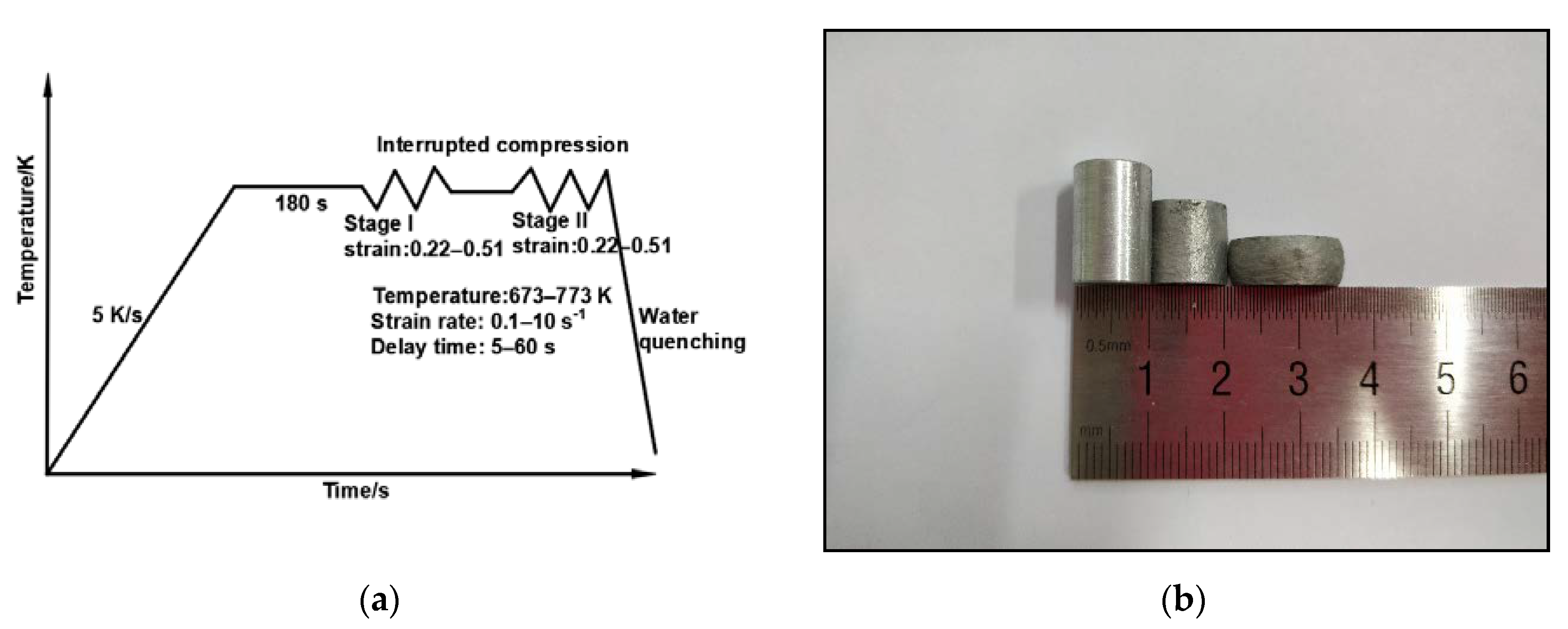
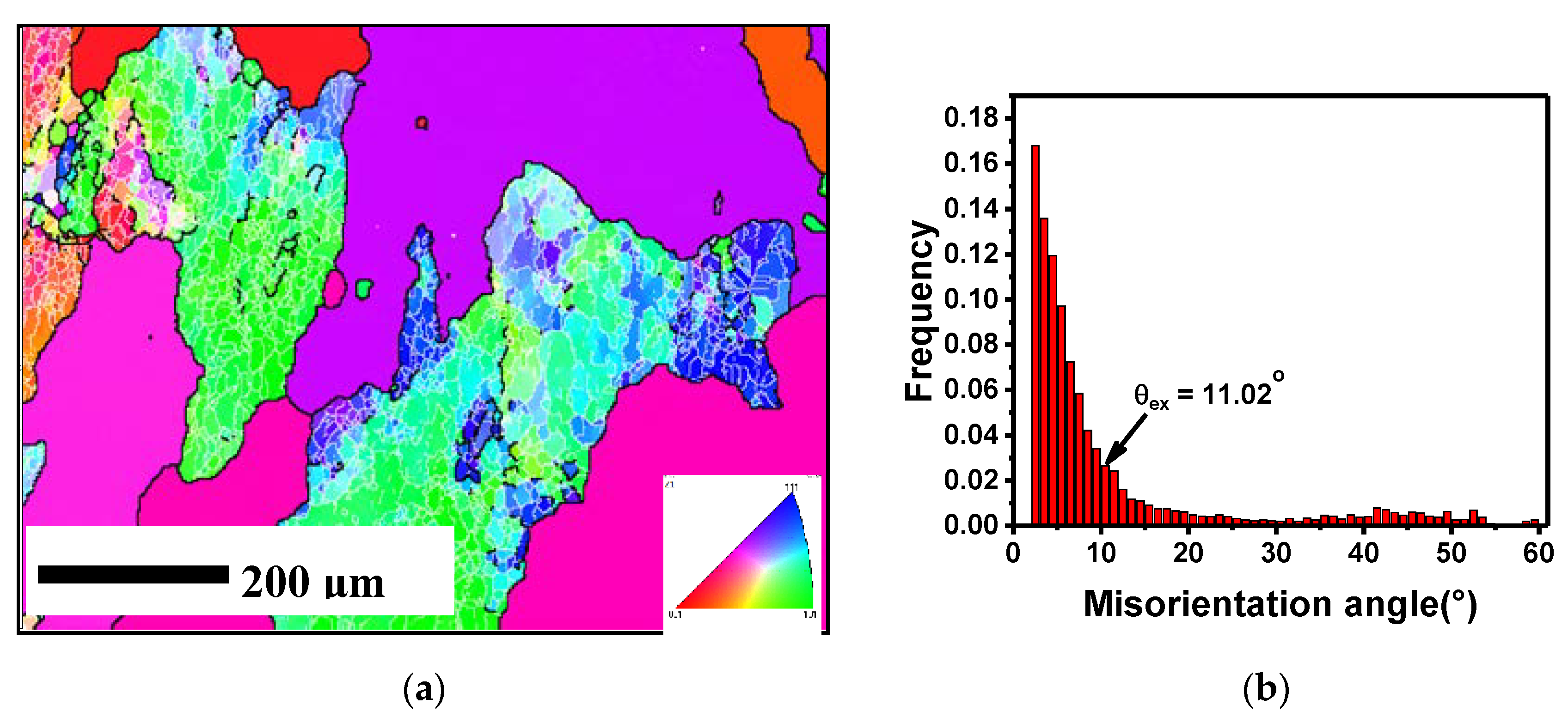

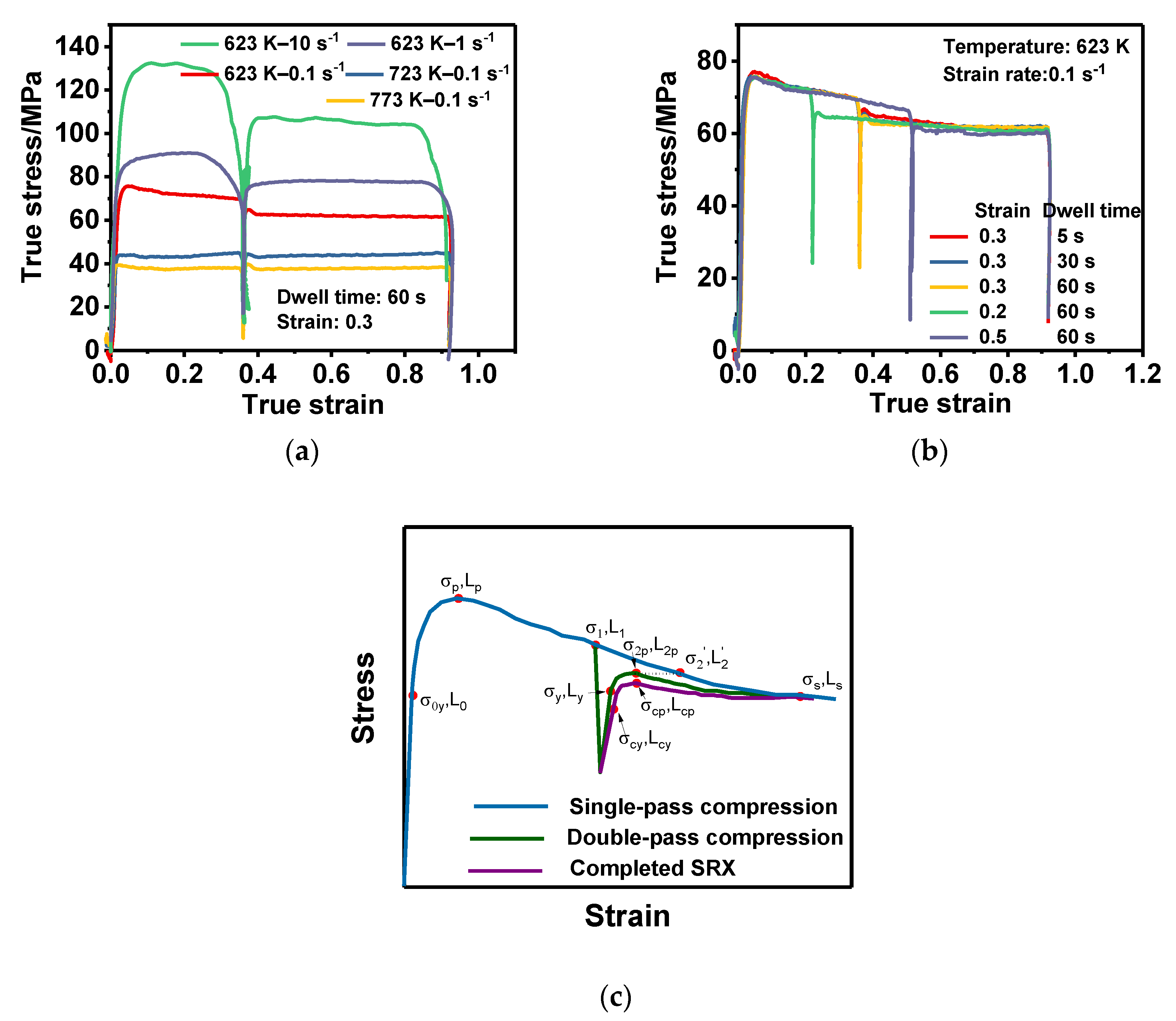
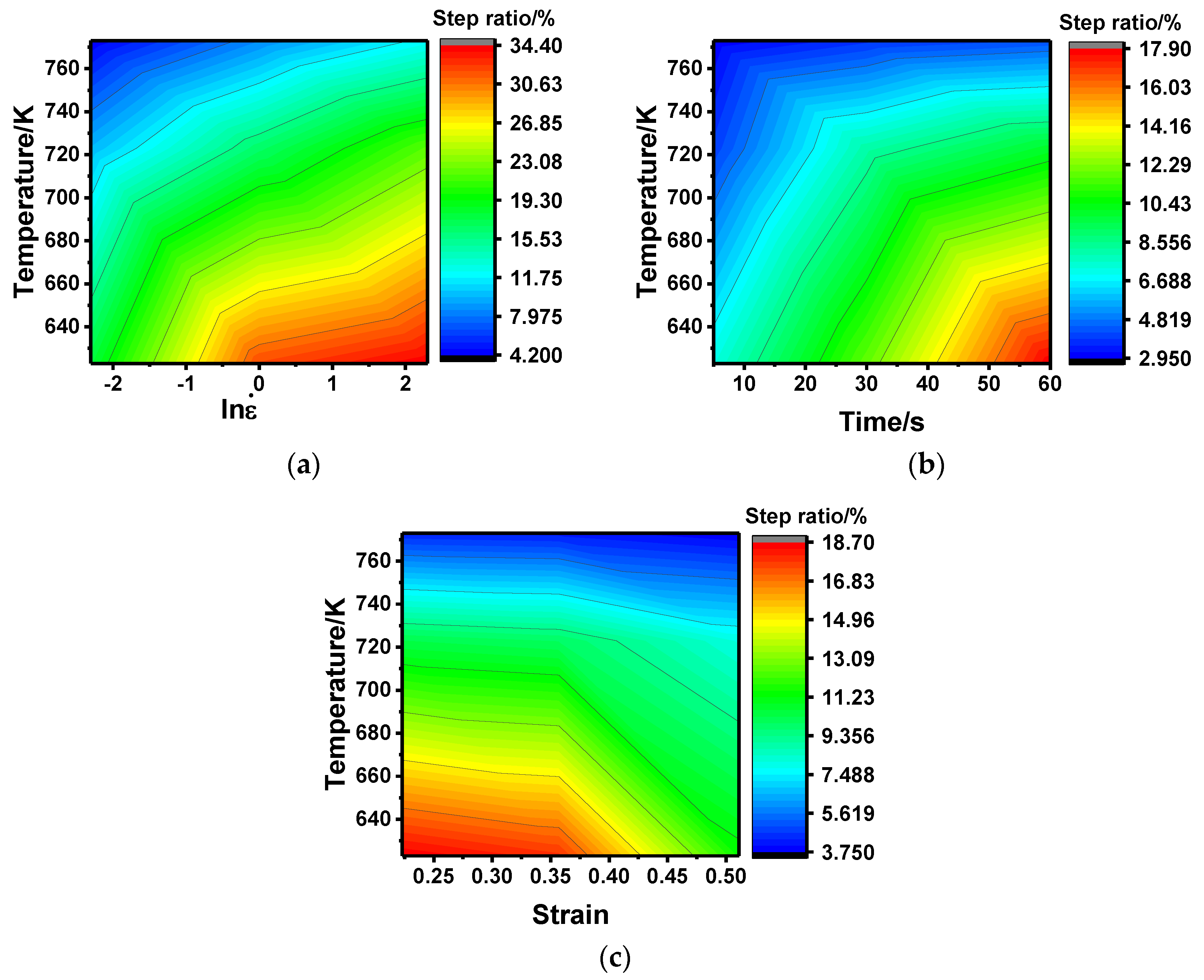
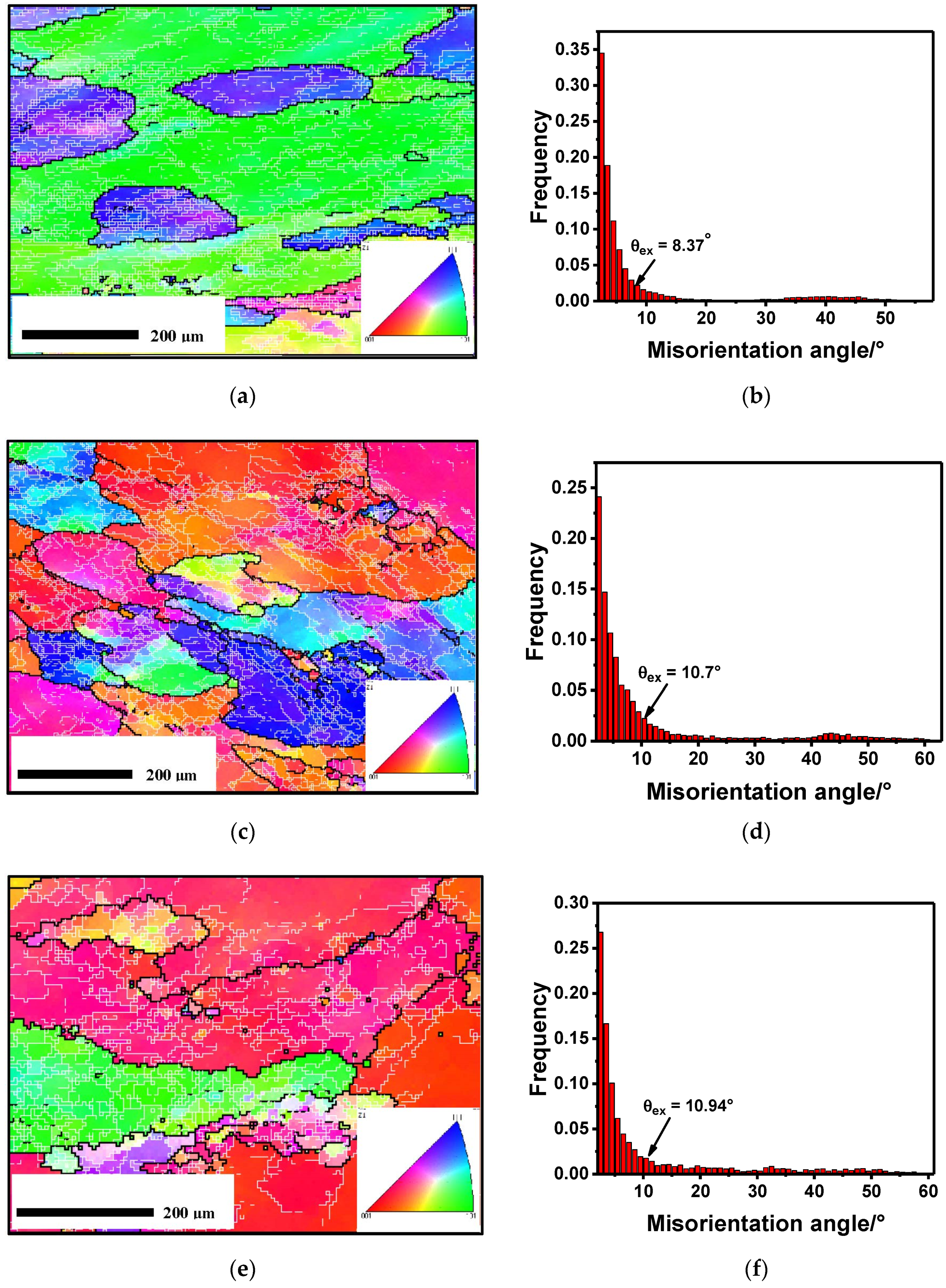
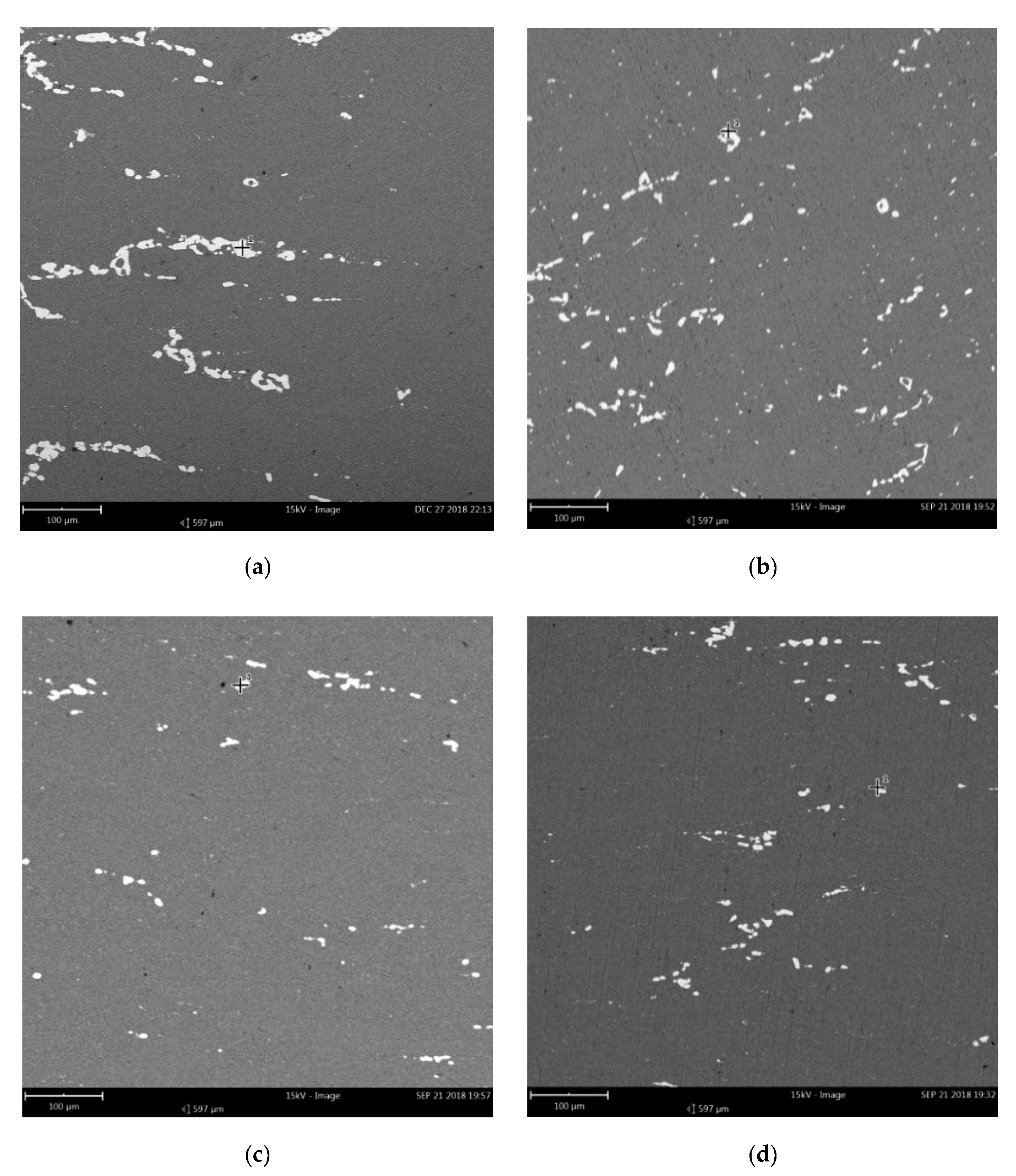
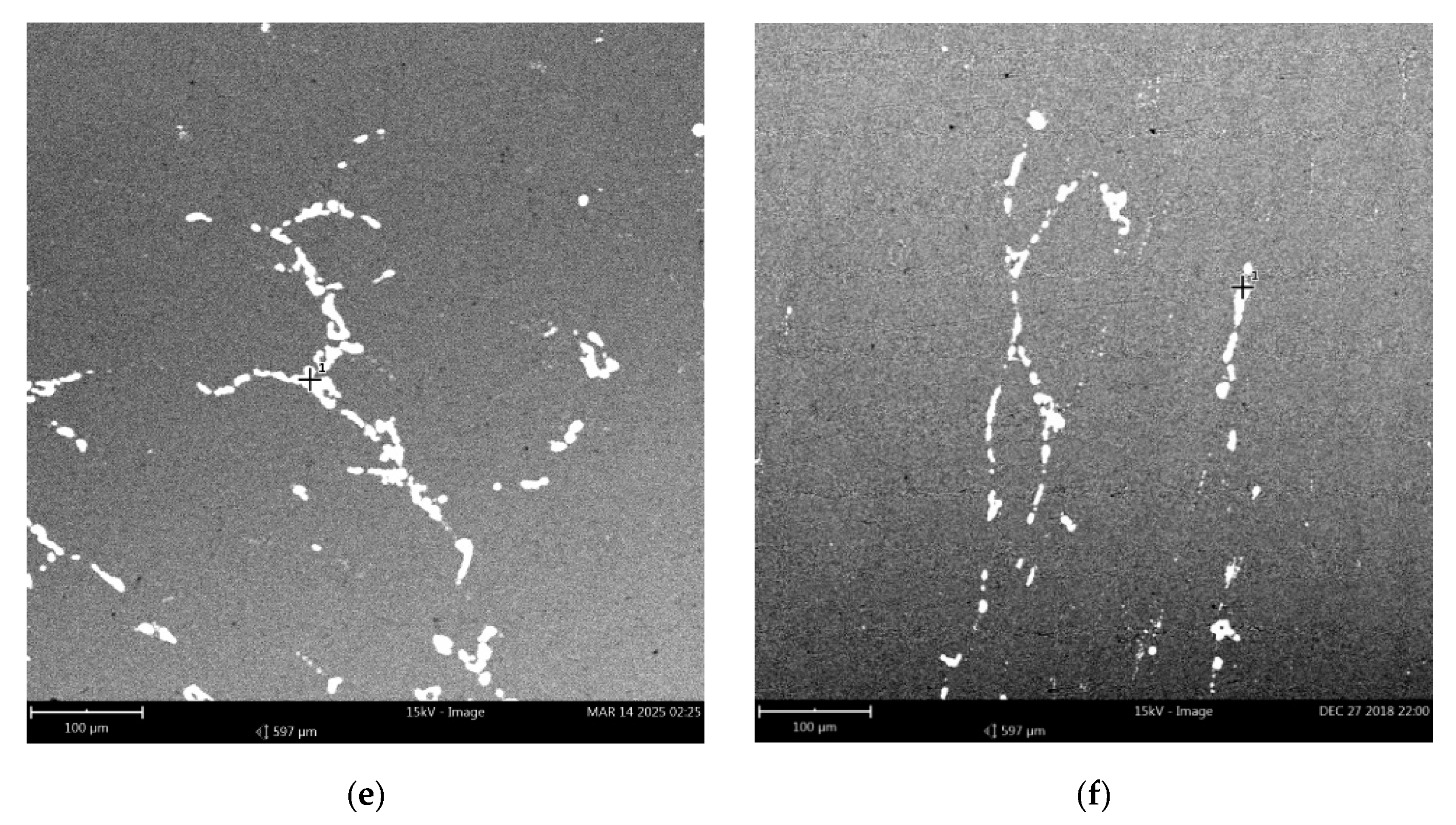


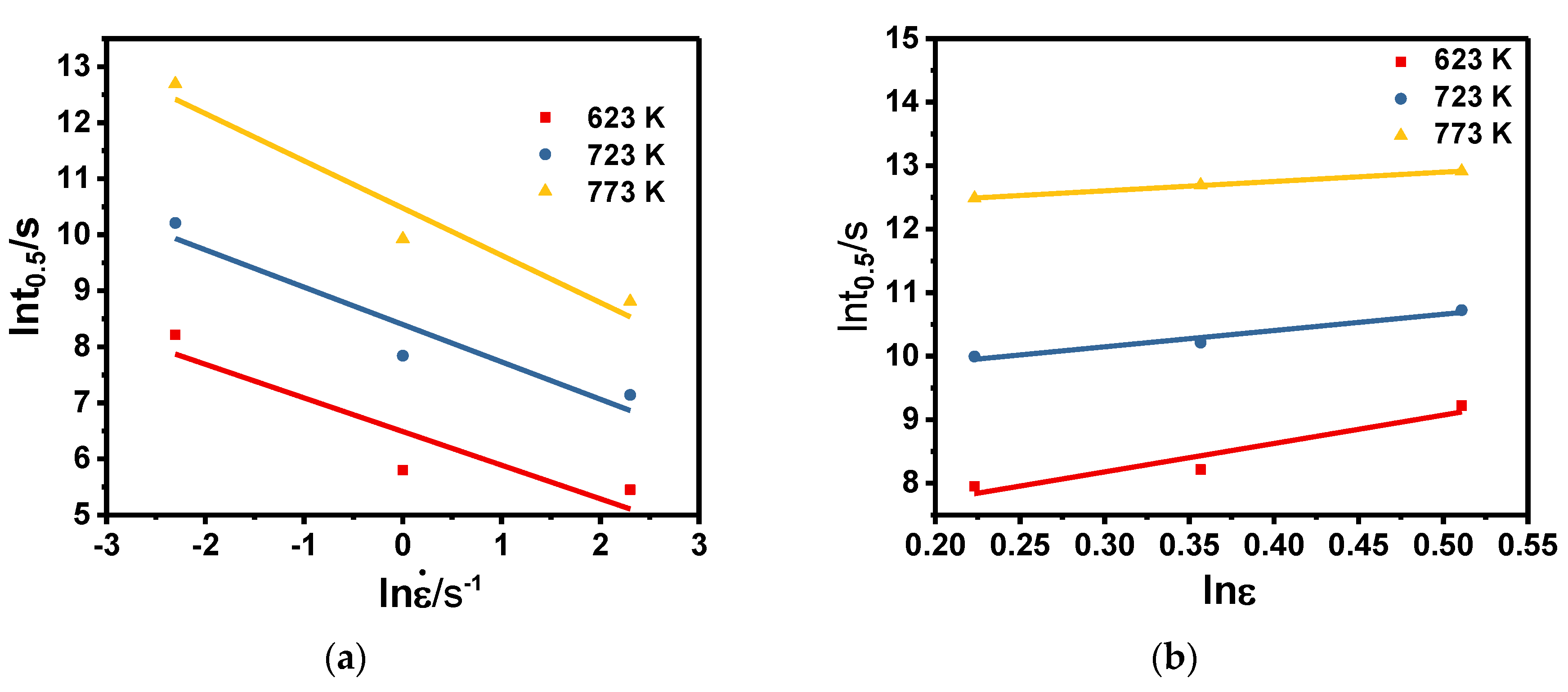
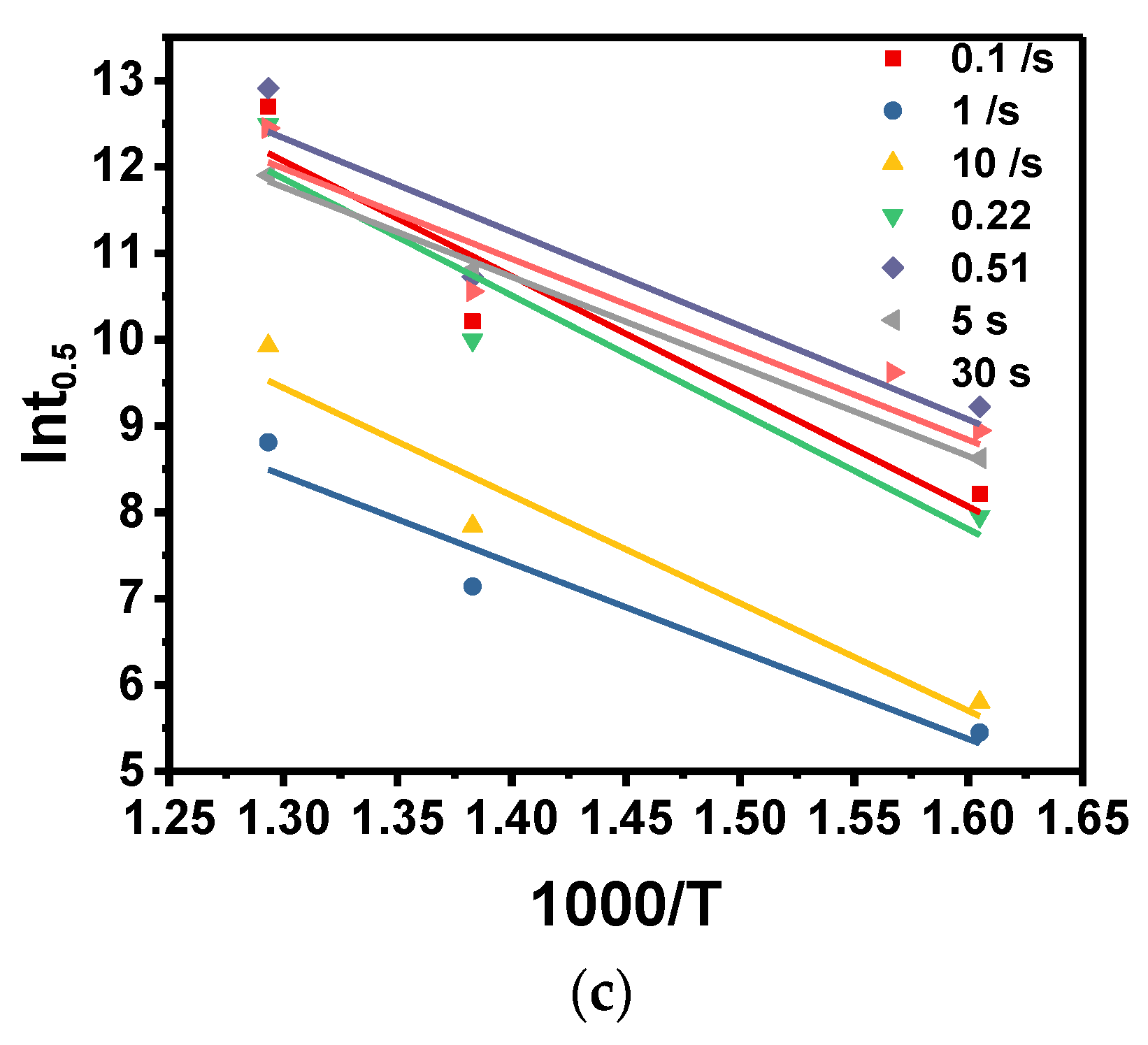

| Material Parameters | 623K–0.1/s–5s–0.36 | 623K–0.1/s–60s–0.36 | 723K–0.1/s–60s–0.22 | 723K–0.1/s–60s–0.51 | 773K–0.1/s–60s–0.36 | 773K–10/s–60s–0.36 |
|---|---|---|---|---|---|---|
| LHAGB/μm | 9.261 × 103 | 1.529 × 104 | 1.046 × 104 | 1.568 × 104 | 1.152 × 104 | 1.245 × 104 |
| ηHAGB | 0.127 | 0.226 | 0.189 | 0.275 | 0.217 | 0.176 |
| θex | 8.035 | 8.37 | 8.74 | 10.704 | 10.942 | 9.171 |
| Parameters | b | c | Qm | lna |
|---|---|---|---|---|
| Values | −0.703 | 2.835 | −98.317 × 103 | 28.567 |
© 2020 by the authors. Licensee MDPI, Basel, Switzerland. This article is an open access article distributed under the terms and conditions of the Creative Commons Attribution (CC BY) license (http://creativecommons.org/licenses/by/4.0/).
Share and Cite
Liu, L.; Wu, Y.; Gong, H.; Ahmad, A.S.; Dong, F.; Yu, H. Static Softening Behavior and Modified Kinetics of Al 2219 Alloy Based on a Double-Pass Hot Compression Test. Materials 2020, 13, 3862. https://doi.org/10.3390/ma13173862
Liu L, Wu Y, Gong H, Ahmad AS, Dong F, Yu H. Static Softening Behavior and Modified Kinetics of Al 2219 Alloy Based on a Double-Pass Hot Compression Test. Materials. 2020; 13(17):3862. https://doi.org/10.3390/ma13173862
Chicago/Turabian StyleLiu, Lei, Yunxin Wu, Hai Gong, Abdulrahaman Shuaibu Ahmad, Fang Dong, and Huamin Yu. 2020. "Static Softening Behavior and Modified Kinetics of Al 2219 Alloy Based on a Double-Pass Hot Compression Test" Materials 13, no. 17: 3862. https://doi.org/10.3390/ma13173862
APA StyleLiu, L., Wu, Y., Gong, H., Ahmad, A. S., Dong, F., & Yu, H. (2020). Static Softening Behavior and Modified Kinetics of Al 2219 Alloy Based on a Double-Pass Hot Compression Test. Materials, 13(17), 3862. https://doi.org/10.3390/ma13173862






